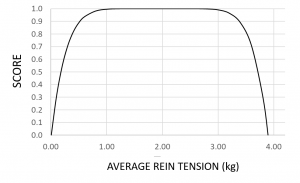What do you suppose the answer to this question should be?
If you ride at a reasonably good standard on a horse you know well you might think that the ideal weight is the one that YOU have. After all – why not, it works for you.
But that means that there are a whole load of ideal rein contact weights that are equally acceptable and that is how we view it at Avansce.
Q1. Is there an ideal weight in the rein contact? – YES! It’s the one that generates a purposeful response from the horse and a feeling of elastic connection through the reins – There is a range of ideal weights
Nevertheless once we start to measure contact weights from many situations we start to see a general trend that represents what can be regarded as the AVERAGE rider/horse partnership.
Let’s get more specific by asking further questions:
Q2. Is it possible to have a contact that is too heavy? – YES! The horse may be protecting itself by grasping the bit, or leaning on the forehand or, worse, the rider is forcing the horse in an attempt to teach him who’s boss.
Q3. Is it possible to have a contact that is too light? – YES! The horse may be protecting itself by backing off the bit and coming behind the vertical, or, the rider assumes that this contact is the one they want even though the horse remains unengaged.
- In the first case discomfort may be preventing the horse from wanting to engage with you through the reins and good horsemanship must try to get to the root of the problem
- In the second case the trainer or coach must decide whether such a light contact is appropriate for your stage of training and ambitions
Q4. But shouldn’t we want to go through the stages of training always with the aim of achieving the lightest possible contact? – YES! but for all practical purposes, particularly when having a goal other than that one as the sole target, it will often be necessary to ride with a firmer contact.
- You will start your journey with a light or perhaps even contactless rein aid
- You will then aim to achieve independence of the hands so that you may safely take a firmer, yet allowing, contact and achieve consistent communication through the reins
- Finally, perhaps over many years, you may return to a light rein aid but returning to it as the seasoned traveller
So, we are saying that there are many acceptable rein contacts that are equally good but there are also bad situations that we want to discourage. Here’s a sketch of how we calculate the quality of that contact weight:

Note that the Synchronicity system will quickly discourage the higher rein tension values that most agree will definitely need moderating. However only at the very lightest (contactless) end of the rein tension scale will the mark be substantially reduced. Only when the beginner can take some sort of light contact will their mark begin to rise. That mark will not be impacted as they progress through their training journey where the weight may increase to varying degrees. The wide range of acceptable contact then allows the largest and most diverse population of riders in the middle of their training journey to train without penalty. They can establish independence of seat and hands and eventually understand that as they return to the lighter contact once again any lower score produced can safely be ignored. Maybe they do not need Synchronicity after that but have been carefully brought through to that stage by the objective feedback that it has continually provided.
